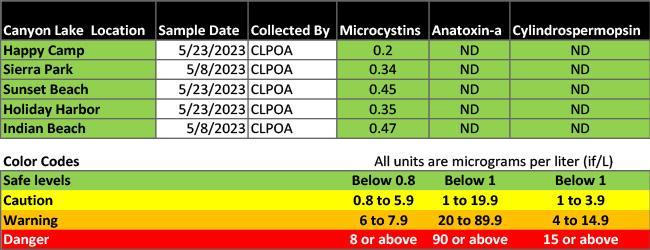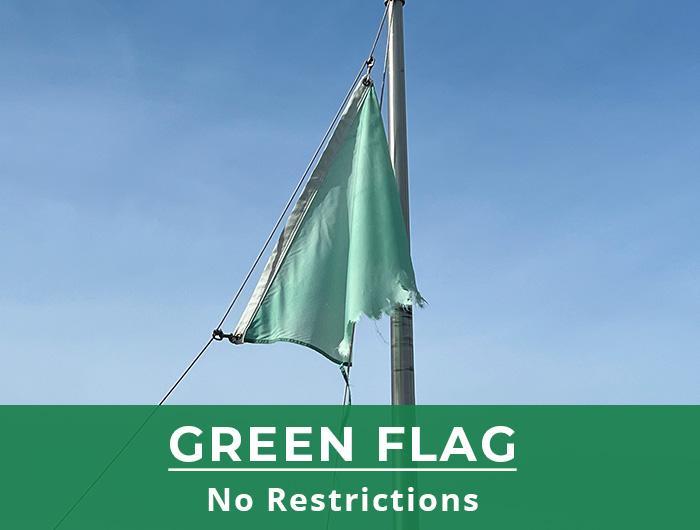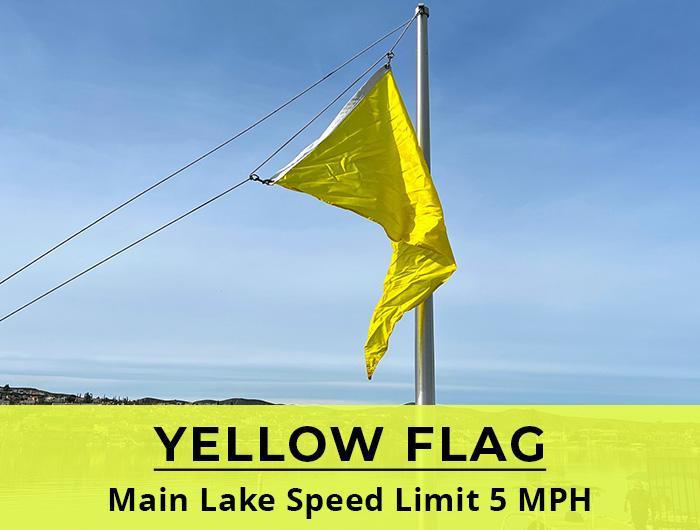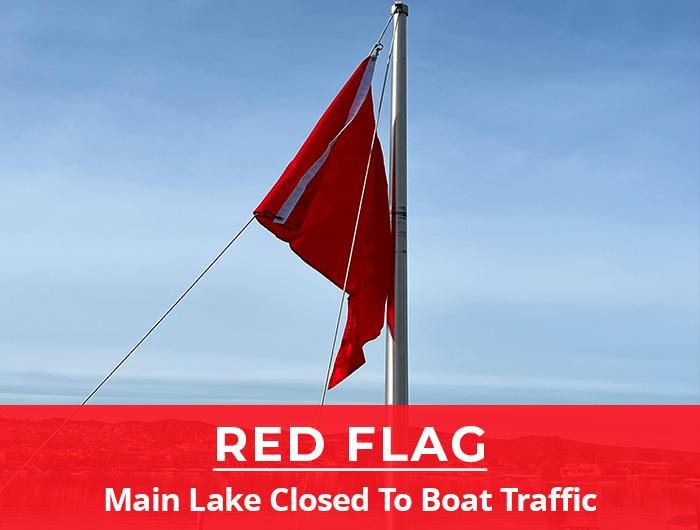Lake Conditions
Lake Condition Updates
Lake Testing Notice
May 17, 2024
On May 8, 2024, water samples were collected from Happy Camp, Holiday Harbor, Indian Beach, Sierra Park, and Sunset Beach and were sent for testing. The results confirmed that all locations are within the safety parameters for recreational activities.

April 25, 2024
Please be advised that Elsinore Valley Municipal Water District (EVMWD) and Canyon Lake POA are initiating lake testing in response to community concerns regarding recent deaths in the fish population. While Yellow Caution signs are posted year-round and remain the current status, we advise residents to exercise caution when deciding to use the lake at this time.
Past Updates
Spring Alum Application - Apr 2024
Spring Alum Application
April 12, 2024
Canyon Lake's spring alum application will begin on Monday, April 22. The lake will remain open during the alum treatment process with little disruption to members during application and implementation. Alum application is a safe method of minimizing algae growth by reducing nutrients in the lake.
Alum Schedule (subject to change)
- April 22: Main body
- April 23: Main body
- April 24: Main boat ramp to the west end of East Bay
- April 25: East Bay and area north of the causeway
- April 26: Clean up
Temporary Lake Closure - Apr 2024
Temporary Lake Closure
April 11, 2024
New test results indicate that the North Ski Area may resume regular operations, and the lake in that area is no longer closed.
April 4, 2024
The North Ski Area is temporarily closed due to elevated bacteria levels resulting from routine post-rainstorm testing. Please refrain from any bodily contact with the water in the area. This closure is for the North Ski Area only.
Temporary Beach Closure - Dec 2023
Temporary Beach Closure
December 26, 2023
EVMWD's test results have concluded that the Holiday Harbor, Sunset Beach, and Happy Camp beaches may reopen. However, it is recommended to avoid body contact on the west side of the tunnel (near the spill location) for the next several days.
December 19, 2023
The beaches at Holiday Harbor, Sunset Beach, and Happy Camp are currently closed due to a sewage spill from the EVMWD sewer pump station on Village Way. Please refrain from any bodily contact with the water in these areas, as it may contain contaminants that pose a health risk. The water quality is being tested at multiple locations, updates from EVMWD will be provided when available.
Fall Alum Application - Sep 2023
Fall Alum Schedule
September 29, 2023
Canyon Lake's fall alum application will begin starting Monday, October 2. Alum application is a safe method of minimizing algae growth by reducing nutrients in the lake. Follow Canyon Lake Alum website for updates.
Alum Schedule (subject to change)
- Oct 2: Main Body
- Oct 3: Main Body
- Oct 4: Main Boat Ramp to West End of East Bay
- Oct 5: East Bay
- Oct 6: North Ski Area/Clean Up
Lake Testing - May 2023
Lake Testing Updates
May 25, 2023
On May 23, 2023, Happy Camp and Sunset Beach water samples were taken and sent to a lab in Sacramento for further testing. Both areas have tested within a safe level to be reopened in time for the Memorial Day weekend.

*ND = Not Detected
>>>View Press Release
May 23, 2023
Please be advised that for several years, the Canyon Lake POA and Elsinore Valley Municipal Water District (EVMWD) have cooperated to test Canyon Lake’s recreational water prior to major holidays. On May 8, 2023, water samples from Happy Camp, Sierra Park, Sunset Beach, Indian Beach, and Holiday Harbor were taken and tested. Unfortunately, Happy Camp and Sunset Beach had elevated results for microcystins that were in the “danger” range on that date. That sampling was done prior to the recent Alum Treatment, which may have some effect on the current water conditions. We are aware that Memorial Day weekend is this weekend, and therefore we are currently taking new samples, which will be rushed to a lab in Sacramento for further testing. We currently expect to have those results back by Friday, and we will publish and update this information at that time.
For now, the State trigger levels tested on May 8, 2023 require that we prohibit all recreational activity in the water at Sunset Beach and Happy Camp, effective immediately. Please avoid the water in these areas. “Danger” level signs are posted at those locations. THIS PAGE WILL BE UPDATED WHEN CONDITIONS AND TEST RESULTS CHANGE.
>>>View Press Release (PDF)
Lake Testing - Aug & Sep 2023
September 1, 2022
Please be advised that Elsinore Valley Municipal Water District (EVMWD) and Canyon Lake POA took water samples from five locations in Canyon Lake on August 16, 2022. Samples were taken from Happy Camp, Sierra Park, Sunset Beach, Indian Beach, and Holiday Harbor. There were no significant levels of microcystins or cyanotoxins detected at any of the five locations sampled.
Full Update Press Releases:
- Lake Testing Update Press Release | 09.01.2022 (PDF)
- Lake Testing Update Press Release | 09.07.2021 (PDF)
- Lake Testing Update Press Release | 07.01.2021 (PDF)
Boating Warning Flags
Boaters are advised to be aware of the boat traffic flags used on the lake. There are three flags used; red flags mean the Main Lake is closed to boat traffic, yellow flags mean the Main Lake is restricted to 5 mph, and green flags mean there are no lake restrictions. These flags are posted at Holiday Harbor to the sides of the flagpole and at the Eastport launch ramp.
Canyon Lake Algal Blooms
As with any lake, ocean, or river in the nation, Canyon Lake’s aquatic ecosystem cannot be compared to a swimming pool that is treated with chemicals to ensure water quality. If you choose to use the lake for swimming, keep in mind that natural lake processes occur and there may be times that the water quality for recreation may pose a health risk.
- Canyon Lake Algae Blooms Facts (PDF) - Updated July 2021
Lake Algae FAQ
1.What are algae?
- Algae are photosynthetic organisms (plants) found naturally in marine and freshwater environments.
- They produce their own food through photosynthesis and are vital for the well-being of marine and freshwater ecosystems.
2.Are any local agencies addressing algae concerns in Canyon Lake?
The Lake Elsinore and San Jacinto Watershed Authority (LESJWA) was formed to improve water quality in Lake Elsinore and Canyon Lake. This organization is made up of stakeholders from around the watershed who are implementing programs such as the alum treatments to Canyon Lake. Many of these programs are grant funded and are a result of numerous lake studies.
3.Who is responsible for lake warnings or closures based on the risk of cyanobacteria or toxins?
- The Canyon Lake POA and EVMWD have partnered on the development and implementation of an HAB monitoring and sampling program.
- The Canyon Lake POA will post signs based on varying risk levels, and for closing/reopening the lake in response to known conditions.
4.When do algae bloom?
- Conditions for algae blooms are ideal when there is an oversupply of nutrients in a lake, such as phosphorus and nitrogen from lawn fertilizers, high temperatures, low oxygen levels in the water, little water movement, and low water levels.
- Algae blooms result when phytoplankton, organisms living on water surfaces, reproduce rapidly and cause dense buildups.
- In a balanced ecosystem, phytoplankton are the food base for many other organisms. However, with an oversupply of nutrients, they experience excessively high growth rates that result in algal blooms.
5.Are algae bad for the lake?
In a balanced ecosystem, most algae are necessary to keep a body of water healthy and productive. However, excessive algae growth reduces water clarity, releases a strong odor, and suffocates aquatic life forms by depleting oxygen levels and blocking sunlight.
6.What are Blue-Green Algae (BGA)?
- While BGA looks very similar to normal algae, it is actually not an algae at all, but a cyanobacteria naturally found in fresh and salt water systems.
- Cyanobacteria have existed in water bodies for centuries and our understanding of them and detection of toxins has improved in recent decades.
- Similar to algae, cyanobacteria use photosynthesis, as well as nitrogen and phosphorus for food.
- Not all BGA blooms are harmful, as only a few very specific strains produce toxins that can result in moderate to severe health complications in humans and animals.
- Toxicity of the algae bloom cannot be detected by simple observation and requires a collection of water samples and lab analyses.
7.What should a resident do when they see an algae bloom?
Refrain from going into water that is foamy, scummy, pea-green, blue-green, brownish red, or looks like floating paint.
8.When in doubt, stay out!
- Do not allow children or pets to play in or drink the water until the algae bloom subsides and drops to the lake bottom. If pets swim in water tinted with an algae bloom, rinse them off immediately.
- Water with mats of algae should not be used for cooking, even if it is filtered or boiled.
9.Do alum treatments being applied to Canyon Lake help reduce algae blooms?
- The alum treatments are designed to reduce the phosphorus levels in Canyon Lake. Common sources of phosphorus include fertilizers, pet waste, natural mineral erosion, and existing lake sediment.
- Phosphorus is often the limiting nutrient for algae, therefore removal of it will likely reduce algae growth.
10.Why hasn't the alum applications prevented algal blooms in the coves?
In some situations, where lake waters are particularly stagnant and shallow as evident around lake coves, algae growth may still occur despite repeated alum treatment. Usually the algae mats in the coves will dissipate over time and drop away within 2-3 weeks.
11.Is there anything I can do to reduce algae?
Yes, together we can all help reduce nutrient inputs to the lake by picking up after our animals, reducing runoff from our irrigation, reducing fertilizer use, and avoid littering in our streets. All of these practices reduce the amount of pollutants that end up in Canyon Lake, which can lead to algae growth.
12.Do algae affect our drinking water?
Canyon Lake is a drinking water reservoir that EVMWD seasonally utilizes to offset costly imported water. After proper treatment, algae does not have any negative health impacts, but can add an earthy taste to drinking water.
13.Who tests Canyon Lake for algae blooms?
In recent years, algae testing has been conducted at Canyon Lake by the Southern California Coastal Water Research Project (SCCWRP) and LESJWA. These tests are not required by State or Federal law and are used for research purposes to help improve water quality.




